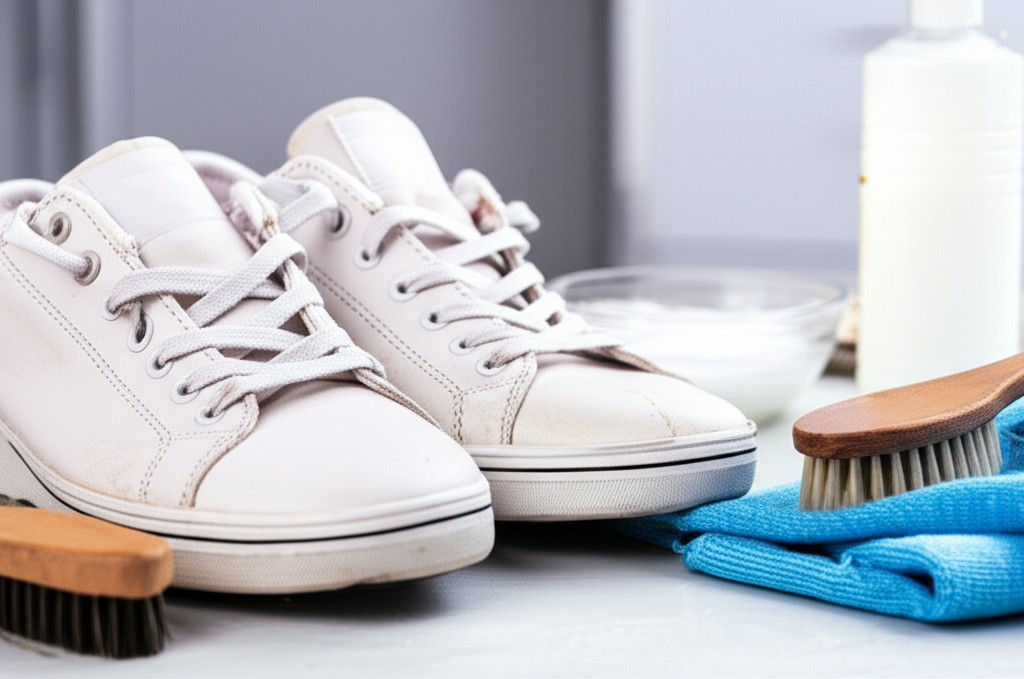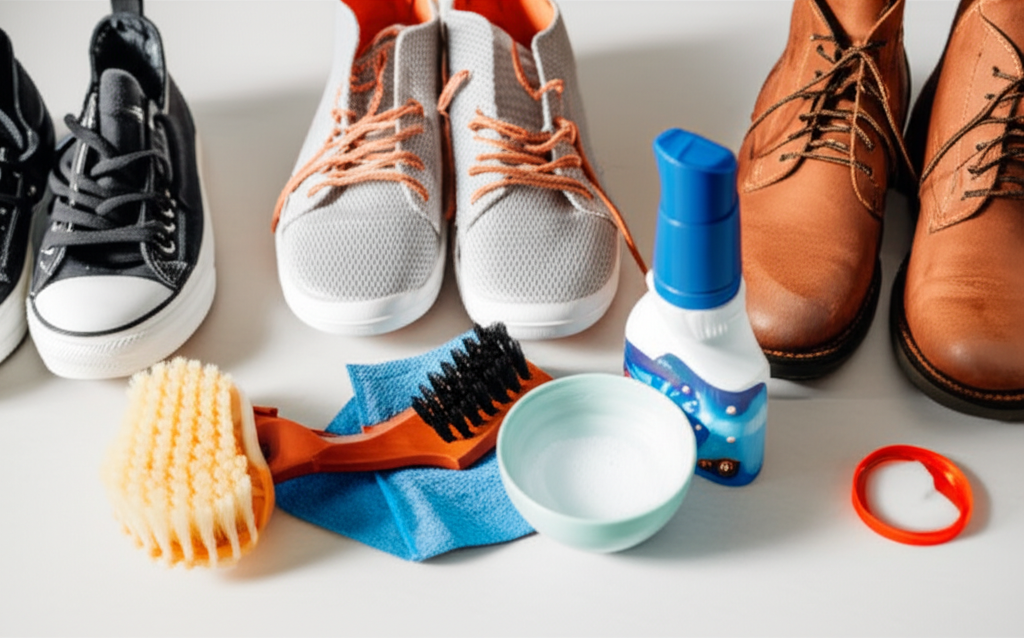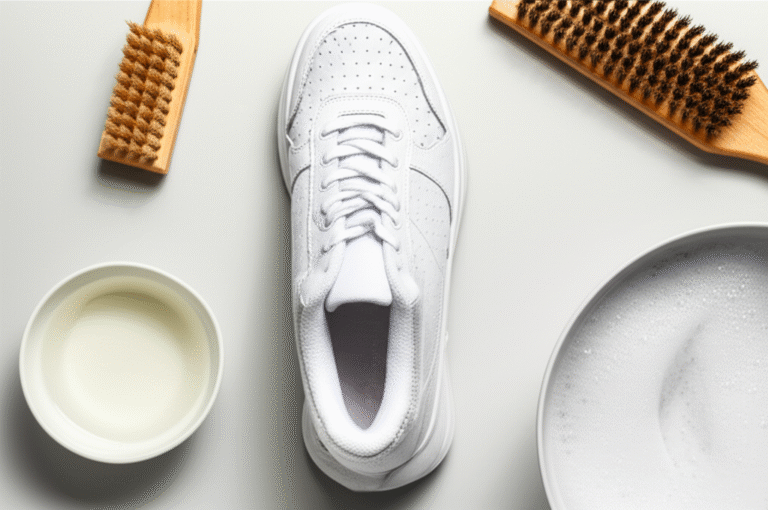Yes, you can easily clean most shoes at home with simple steps and common household items! This guide shows you how to clean shoes effectively, tackling dirt, stains, and odors for sneakers, leather, suede, and more, making them look fresh and last longer.
Key Takeaways
- Gather essential cleaning supplies before starting.
- Remove loose dirt and debris first.
- Use specific methods for different shoe materials.
- Address tough stains with targeted solutions.
- Dry shoes properly to prevent damage.
- Deodorize and protect your clean shoes.
How to Clean Shoes at Home: Your Effortless Guide
Do your favorite shoes look a little worse for wear? It’s a common problem. Dirt, scuffs, and everyday wear can make even the newest shoes appear old and tired. But before you think about replacing them or spending money on expensive professional cleaning, know that you can often restore their former glory right in your own home. Cleaning shoes at home might seem daunting, especially with different materials like leather, suede, or mesh, but it doesn’t have to be complicated. This guide will walk you through everything you need to know, step by step, to make your shoes look like new again without any fuss.
Why Cleaning Your Shoes Matters

Keeping your shoes clean is more than just about aesthetics; it plays a vital role in their longevity and your comfort. Regularly cleaning your shoes removes dirt and grime that can break down materials over time, leading to premature wear and tear. For instance, salt and mud can damage leather, while trapped moisture in athletic shoes can foster bacteria and unpleasant odors. Proper cleaning also helps maintain the structural integrity of your footwear, ensuring they provide the support and comfort you rely on. Plus, clean shoes simply make you feel better and more put-together.
Essential Shoe Cleaning Supplies
Before you dive into cleaning, gather your tools. Having the right supplies on hand makes the process much smoother and more effective. You don’t need a lot of fancy equipment; most items are probably already in your home.
The Must-Have Cleaning Arsenal
- Soft Bristle Brush: Ideal for gentle scrubbing and removing loose dirt without damaging materials. An old toothbrush works well for details.
- Microfiber Cloths: Essential for wiping, drying, and buffing. Keep a few clean ones handy.
- Mild Soap or Detergent: A small amount of dish soap, laundry detergent, or specialized shoe cleaner is perfect.
- Water: For rinsing and diluting cleaning solutions.
- Baking Soda: A natural deodorizer and mild abrasive.
- White Vinegar: Effective for stain removal and odor control.
- Cotton Swabs: Great for cleaning hard-to-reach areas and precise stain treatment.
- Newspaper or Paper Towels: For stuffing shoes to help them retain their shape and absorb moisture.
- Shoe Protector Spray: To guard against future stains and water damage.
General Shoe Cleaning Steps: The Foundation

These steps form the basis for cleaning most types of shoes. Once you master this general approach, you can adapt it to specific materials.
Step 1: Remove Loose Dirt and Debris
This is crucial. Before introducing any moisture, grab your soft bristle brush or a dry cloth and gently brush off all the surface dirt. Pay attention to the soles, the edges, and any crevices where dirt likes to hide. If your shoes are very muddy, you might want to tap the soles together outside to dislodge larger clumps first.
Step 2: Prepare Your Cleaning Solution
In a small bowl, mix a few drops of mild soap or detergent with warm water. You want a lightly sudsy solution, not a thick lather. For tougher stains, you might consider a specialized shoe cleaner, but for most general cleaning, this simple mixture will suffice. Avoid using harsh chemicals like bleach or ammonia, as they can damage shoe materials and colors.
Step 3: Gentle Scrubbing
Dip your brush into the cleaning solution, wring out any excess water, and begin gently scrubbing the shoes. Work in small, circular motions. Focus on stained areas, but don’t scrub too hard, especially on delicate materials. For intricate designs or seams, a cotton swab dipped in the solution can be very effective.
Step 4: Wipe and Rinse
Use a clean, damp microfiber cloth to wipe away the soap residue and dirt. Rinse the cloth frequently in clean water. You want to remove all traces of the cleaning solution to prevent water spots or material degradation. For very dirty shoes, you might need to repeat the scrubbing and wiping process.
Step 5: Drying Your Shoes
This is a critical step that many people get wrong. Never put your shoes in a clothes dryer or expose them to direct heat from a radiator or sunlight. High heat can warp shoe shapes, crack adhesives, and damage materials. Instead, stuff the shoes loosely with newspaper or paper towels. This helps them absorb internal moisture and maintain their shape. Let them air dry at room temperature in a well-ventilated area. It may take 24 hours or longer for shoes to dry completely.
Cleaning Different Shoe Materials: A Deeper Dive
Different materials require different care. Here’s how to tackle common shoe types.
How to Clean Sneakers (Canvas, Mesh, Synthetic)
Sneakers are often made from breathable materials like canvas, mesh, and synthetic fabrics. These are generally quite durable and can withstand a bit more cleaning action.
Canvas and Mesh Sneakers:
- Pre-treatment: Brush off loose dirt. For stubborn dirt, you can create a paste of baking soda and water and apply it to stained areas. Let it sit for about 15-20 minutes.
- Washing: Mix mild detergent with warm water. Use a soft brush or an old toothbrush to scrub the uppers and midsoles.
- Laces: Remove laces and wash them separately. You can hand wash them in soapy water or place them in a mesh laundry bag and wash them with your regular clothes.
- Rinsing: Wipe down with a damp cloth. Avoid soaking canvas or mesh shoes unless they are designed for it, as excessive water can weaken adhesives.
- Drying: Stuff with paper towels and air dry.
Synthetic Sneakers:
Synthetics are often very forgiving. Follow the general steps above. A mild soap and water solution is usually sufficient. For scuffs on synthetic leather or plastic parts, a magic eraser can be surprisingly effective, but test on an inconspicuous area first.
Pro Tip: For white canvas or mesh sneakers, a paste of baking soda and hydrogen peroxide can help brighten them up. Apply, let it sit for 30 minutes, then gently scrub and wipe clean.
How to Clean Leather Shoes
Leather requires a gentler approach to maintain its natural oils and prevent drying or cracking.
Leather Care Steps:
- Preparation: Remove laces. Wipe down the shoes with a slightly damp cloth to remove surface dust.
- Cleaning: Use a dedicated leather cleaner or a very mild soap solution (e.g., a tiny bit of saddle soap or mild hand soap mixed with water). Apply sparingly with a soft cloth, working in sections. Gently wipe away dirt and grime.
- Conditioning: This is key for leather. After cleaning and drying, apply a good quality leather conditioner. This replenishes the oils, keeps the leather supple, and prevents cracking. Apply a small amount with a clean cloth and buff gently.
- Polishing (Optional): For a polished look, apply a matching shoe polish with a dauber brush or cloth, then buff with a horsehair brush or soft cloth until shiny.
- Drying: Air dry completely before conditioning or polishing.
External Resource: For a deeper understanding of leather care, the Library of Congress provides excellent guidelines on preserving organic materials, which can be applied conceptually to leather care.
How to Clean Suede and Nubuck Shoes
Suede and nubuck are delicate and require specialized tools and techniques. Water can stain them permanently, so use it sparingly, if at all.
Suede/Nubuck Cleaning Method:
- Dry Brushing: Always start with a clean, dry suede brush. Brush in one direction to lift the nap and remove loose dirt. For more stubborn marks, brush back and forth gently.
- Eraser Power: For scuffs and marks, a suede eraser (or a clean pencil eraser) is your best friend. Rub gently over the mark.
- Stubborn Stains: For grease or oil stains, try sprinkling cornstarch or baking soda on the stain immediately. Let it sit for a few hours or overnight to absorb the oil, then brush away. For water stains, once dry, gently brush the suede to try and restore the nap.
- Deep Cleaning (Use with Caution): If absolutely necessary, you can use a specialized suede cleaner. Follow the product instructions precisely, usually involving applying a foam, letting it dry, and then brushing. Always test on an inconspicuous area first.
- Protection: After cleaning and drying, apply a suede protector spray to help repel water and stains in the future.
Important Note: Never use water directly on suede or nubuck unless the product specifically instructs you to do so with a specialized cleaner. These materials are very sensitive to moisture.
How to Clean Athletic/Running Shoes
Athletic shoes are designed for performance, but they also accumulate sweat, dirt, and odor. Proper cleaning can extend their life and keep them fresh.
Athletic Shoe Care:
- Remove Insoles and Laces: Take out the insoles and laces.
- Brush Off Dirt: Use a dry brush to remove loose dirt from the uppers and soles.
- Clean Uppers: Mix a mild detergent with warm water. Use a soft brush to gently scrub the mesh, synthetic, and rubber parts.
- Clean Midsoles: The midsole (the thick part between the upper and the outsole) often gets dirty. A toothbrush dipped in your cleaning solution works well here. For scuffs on white midsoles, a magic eraser can be very effective.
- Wash Laces and Insoles: Hand wash laces in soapy water. Insoles can often be wiped down with a damp cloth and a bit of baking soda solution to help with odor. Allow them to air dry completely.
- Rinse and Dry: Wipe down the shoes with a damp cloth to remove soap residue. Stuff with newspaper and air dry thoroughly away from heat.
How to Clean White Shoes
White shoes are notorious for showing every speck of dirt. The good news is that with the right techniques, you can keep them looking pristine.
White Shoe Revitalization:
- General Cleaning: Follow the steps for your shoe’s material (sneaker, leather, etc.), but be extra diligent about removing all residue.
- Whitening Boost: For canvas and mesh, a paste of baking soda and hydrogen peroxide is excellent. For leather, a white shoe polish or cream can cover scuffs.
- Magic Eraser: This is a miracle worker for scuffs on rubber soles, plastic, and some synthetic uppers. Gently rub the affected area.
- Toothpaste: Non-gel white toothpaste can be used as a mild abrasive on white rubber soles and some white synthetic uppers. Apply with a toothbrush, scrub, and wipe clean.
- Sole Cleaning: For deep grime on soles, a stiff brush and a slightly stronger soap solution, or even a gentle cleaner like Goo Gone (test first!), can be effective.
Tackling Tough Stains and Odors
Sometimes, general cleaning isn’t enough. Here’s how to deal with common shoe problems.
Dealing with Specific Stains
Different stains require different approaches:
- Grease/Oil: Act fast. Absorb as much as possible with a paper towel. Then, sprinkle cornstarch or baking soda on the stain. Let it sit for several hours to absorb, then brush off. Repeat if necessary.
- Mud: Let mud dry completely. Then, brush off as much as possible before proceeding with regular cleaning.
- Ink: For leather, a small amount of rubbing alcohol on a cotton swab can sometimes lift ink. Test in an inconspicuous area first and be prepared to condition the leather afterward. For fabric, try a stain remover stick or a paste of baking soda and water.
- Grass Stains: These can be tough. Try a pre-wash stain remover or a paste of white vinegar and baking soda.
Eliminating Shoe Odors
Bad smells are usually caused by bacteria. Here’s how to combat them:
- Baking Soda: Sprinkle a generous amount of baking soda inside your shoes and let it sit overnight. Vacuum or shake it out in the morning.
- Vinegar Spray: Mix equal parts white vinegar and water in a spray bottle. Lightly mist the inside of your shoes. Let them air dry completely. The vinegar smell will dissipate as it dries.
- Sunlight: UV rays can help kill odor-causing bacteria. Airing shoes out in direct sunlight for a few hours can be beneficial, but be mindful of potential fading on certain materials.
- Dryer Sheets: Placing a dryer sheet inside each shoe overnight can absorb odors and leave a fresh scent.
- Specialized Shoe Deodorizers: There are many sprays and inserts available designed specifically to neutralize shoe odors.
Protecting Your Clean Shoes
Once your shoes are clean and dry, it’s wise to protect them to keep them looking good for longer.
Water and Stain Repellents
Invest in a good quality waterproofing or stain-repellent spray. These sprays create a barrier on the shoe’s surface, making it harder for liquids and dirt to penetrate. Make sure to choose a spray appropriate for your shoe material (e.g., suede protector, leather protector, fabric protector).
Application: Ensure shoes are clean and dry. Spray evenly from about 6-8 inches away. Let them dry completely. Reapply periodically, especially after heavy wear or exposure to the elements.
Storage Matters
Proper storage prevents dust buildup and helps shoes maintain their shape. Store them in a cool, dry place. If you have the original boxes, use them. Otherwise, consider shoe bags or shelves. Avoid stacking shoes directly on top of each other, especially leather or delicate materials.
Frequently Asked Questions (FAQ)
Q1: Can I put my sneakers in the washing machine?
A1: For many canvas, mesh, or synthetic sneakers, yes, you can. However, always remove laces and insoles first. Place shoes in a mesh laundry bag or pillowcase. Use a gentle cycle with cold water and mild detergent. Avoid the dryer; air dry them completely. Check the manufacturer’s care instructions if available. Delicate materials or shoes with glued-on embellishments might not be suitable for machine washing.
Q2: How often should I clean my shoes?
A2: It depends on how often you wear them and the conditions. For everyday shoes, a quick wipe-down after each wear can prevent dirt buildup. Deep cleaning might be needed every few weeks or months, or whenever they look visibly dirty or start to smell. Athletic shoes worn for exercise may need more frequent cleaning.
Q3: What’s the best way to clean white rubber soles?
A3: White rubber soles can be cleaned effectively with a magic eraser, a toothbrush and toothpaste (non-gel, white), or a paste of baking soda and water. For very stubborn grime, a mild all-purpose cleaner or diluted bleach solution (use with extreme caution and test first) might work, followed by thorough rinsing.
Q4: My leather shoes got wet. What should I do?
A4: Blot excess water immediately with a dry cloth. Do not use heat. Stuff them with newspaper or paper towels to absorb moisture and help them retain their shape. Let them air dry completely at room temperature. Once dry, apply a leather conditioner to restore moisture and suppleness.
Q5: Can I use baby wipes to clean my shoes?
A5: Baby wipes can be useful for a quick spot clean on non-porous surfaces like smooth leather or some synthetic materials to remove light dirt. However, they may not be effective for deep cleaning and can sometimes leave a residue. Always test on an inconspicuous area first.
Q6: How do I remove salt stains from my shoes?
A6: For leather shoes, mix equal parts white vinegar and water. Dampen a cloth with this solution and gently wipe away the salt stains. Follow up by wiping with a clean, damp cloth and then applying a leather conditioner. For fabric shoes, a similar vinegar and water solution or a specialized shoe cleaner can be used.
Conclusion
Cleaning shoes at home is an achievable and rewarding task. By understanding the basic principles and tailoring your approach to different materials, you can significantly extend the life of your footwear, keep them looking their best, and save money in the process. Remember to always start with the gentlest method and work your way up if needed. With the right tools and a little patience, your favorite shoes will be ready for their next adventure, looking and feeling fresh.

